IDEX Online Research: Consumer Jewelry Expenditures – 2006 Customer Base Broadens
July 15, 08
The year 2006 was a great year for U.S. jewelers. Not only were sales strong, but the industry’s customer base expanded significantly beyond those consumers who have historically bought jewelry. Based on newly released data from the U.S. government, a broader consumer segment purchased jewelry in 2006 than ever before.
In other words, in addition to reaching existing customers who have shopped for jewelry, jewelers reached new customers, many who had not purchased jewelry for perhaps several years.
The newly released data from the Bureau of Labor Statistics (BLS) shows that some multi-year consumer jewelry expenditure trends were shattered, while others seem to have stood the test of time. Their detailed research about consumer spending patterns for 2006 confirms that spending by consumers on jewelry continues to evolve.
These are the highlights from the government’s most recent Consumer Expenditure Survey for 2006, the latest data available.
- Total jewelry sales strong – Jewelry sales in the U.S. were up 6.5 percent in 2006 to $62.2 billion. This was one of the strongest gains in this decade.
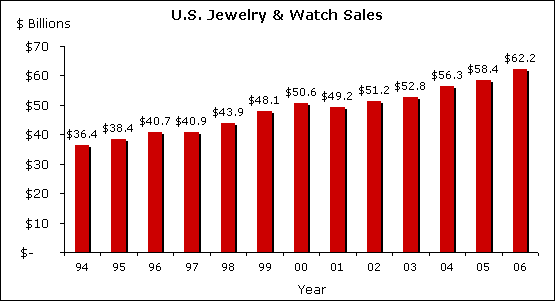 Source: US Dept of Commerce |
- Household expenditures on jewelry reached record levels – The average U.S. household spent $523 on jewelry in 2006, up from the prior year’s $502. That’s a 4.2 percent increase in per-household spending, up notably from the prior year. Consumer jewelry expenditures of $523 per household are the highest on record.
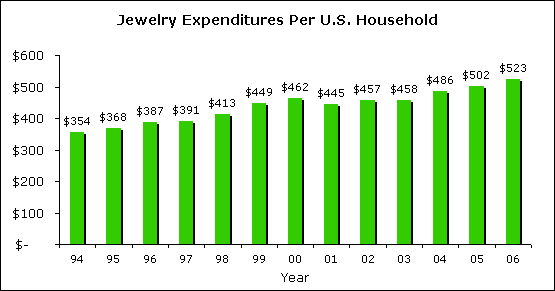
Source: US Dept of Commerce
- Household formations expand the market – The total number of households increased by about 1.3 percent to 118.8 million; that gain is in line with the past ten-year average increase.
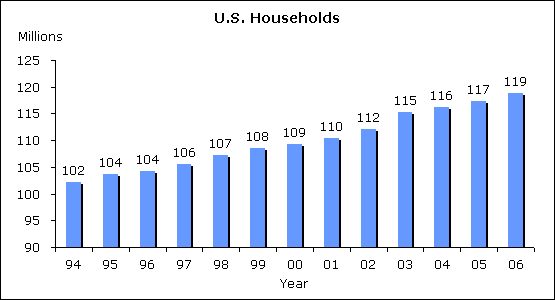
Source: CES
- Jewelry took market share from other retail categories – Total U.S. retail sales increased by 5.5 percent in 2006. Because jewelry sales grew at a greater rate, jewelry took a small amount of market share from other retail categories.
- Consumers of all ages buy jewelry – All ages bought jewelry in 2006. In the past, jewelry purchases were heavily biased toward young Millennials – 25-34 years old – and Boomers over 55 years old. In 2006, the highest jewelry expenditures per household were among those shoppers age 35-44; historically, jewelry expenditures by these consumers have been below average.
- Middle income consumers have increasingly become significant jewelry buyers – Middle income consumers spent more on jewelry than ever before. While jewelry purchases are still heavily biased toward households with annual incomes above $70,000, consumers in the $30-50,000 income range and $50-70,000 income range spent proportionally more on jewelry than ever before.
- New jewelry shoppers are coming into the market – Most other demographic factors reflected the same trends – jewelry spending increased proportionally more in among consumers who had historically under-spent on this category.
- Jewelry’s share of wallet held about steady – Jewelry’s share of wallet was about 0.86 percent of total consumer expenditures, up by a minuscule amount from the prior year.
- Gift purchases of jewelry were up significantly – U.S. consumers spent much more on jewelry as a gift than in the prior year. The data for 2006 suggests that gift spending for jewelry has reverted to the long term mean – about 15 percent of all jewelry expenditures are for gifts.
- The number of shopping trips for jewelry held about constant – Consumers shopped for jewelry with about the same frequency as in the past. About one-in-five U.S. households shop for jewelry, and they make 2-4 trips per year to buy jewelry. However, among the highest income consumers, about two-in-five of those households shop for jewelry each year – double the national average – and they make 4-6 trips annually to guild jewelry stores to purchase gemstones and precious metal jewelry.
- Energy costs took a big bite out of consumers’ discretionary spending – There were some notable swings in consumers’ spending in some other categories. While the price of gasoline in 2006 was only a fraction of today’s price, it was climbing. As a result, the typical U.S. consumer spent 3.7 percent of their income on gasoline for their automobile in 2006, up from 3.4 percent in the prior year. Housing was also booming in 2006, and consumers wanted to get in on the action. As a result, they took on larger mortgages and purchased more vacation homes; this increased their spending on housing to 27.0 percent share of wallet from 25.8 percent in 2005. Where did consumers cut corners? They spent notably less on self-education, insurance and entertainment.
Gains in 2006 Likely To Be Given Up in 2007 and 2008
While forecasts are not normally a part of this series, it would appear that 2006 was a banner year for the U.S. jewelry industry. We do not expect to see the same results for 2007 – indeed, jewelry sales were up a more moderate 4.1 percent, about in line with the total retail sales gain – nor do we expect to see consumer expenditures on jewelry particularly strong in 2008 due to economic weakness, a credit crunch, a housing crisis and soaring energy costs.
Consumer Expenditure Survey Background
Each year, the Bureau of Labor Statistics (BLS) conducts a highly detailed Consumer Expenditure Survey. Consumers are given diaries and asked to account for every penny of their spending every day for two consecutive one-week periods. In addition, five interviews with consumers are conducted at three-month intervals. Between the detailed diaries and the interviews, the BLS survey overlooks virtually nothing.
Do you want to know how much people spend for peanut butter each year? It’s in the survey. Data about every conceivable expenditure, right down to the final penny, is available in the CES, including detailed spending data on jewelry and watch sales, jewelry gift spending, jewelry repair spending, flatware, silver service and other detailed spending information.
In addition to the usual annual demographic profiles of the American jewelry shopper, new data is available on the number of U.S. households that actually purchase jewelry (about one-in-four), how much the typical jewelry shopper spends in a year (just above $2,000), and an estimate of the number of shopping trips in a year during which a jewelry purchase is made (it depends on who the consumer is).
There is a major caveat to all of this consumer demographic and spending data: it represents a mathematical average. Averages can be deceiving. For example, the average age of the typical American consumer in 2005 was 48.6 years. That average was calculated by averaging the ages of all 300 million American consumers; it really is meaningless. However, when researchers drill down into detailed statistics, the “averages” become much more meaningful, because they are looking at a small segment of consumers.
Best Jewelry Shopper
Based on the latest data from the Consumer Expenditure Survey, the following table summarizes the “best” American jewelry shopper. Key demographic factors are listed in order of importance. For example, consumer households with an annual income of $70,000 or higher spend $1,003 annually on jewelry; that’s double the amount spent – $523 – by the average household.
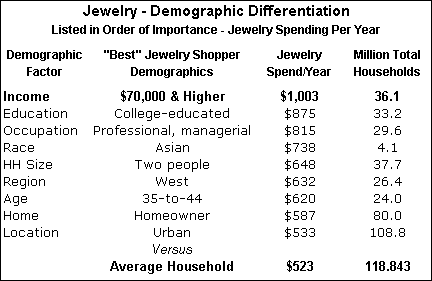
Source: US Dept of Commerce
The bottom line analysis of these demographic characteristics, including those which have changed and those which have not changed, is that our long term jewelry forecast for above average sales gains remains intact. We continue to believe that jewelry sales will grow by at least 5 percent annually between now and 2025, somewhat above the average growth forecast for all retail categories of about 4.5 percent.
The Typical American Household: Virtually Unchanged, Except for Income
The following table summarizes the key demographic characteristics of the average American household. Aside from a consistent increase in income – up nearly 15 percent in two years – the only other notable changes are the age of the head of the household and the number of vehicles. The aging of households is due to the bubble of Baby Boomers who are getting older.
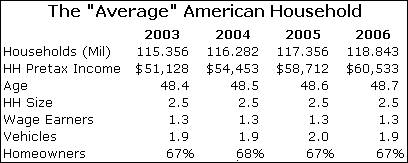 Source: CES |